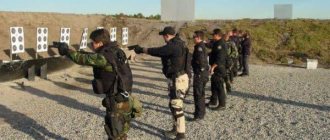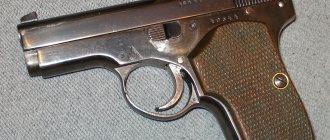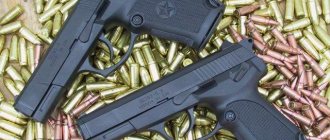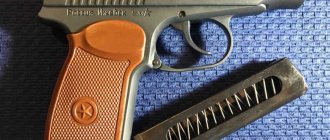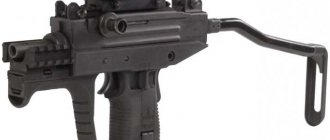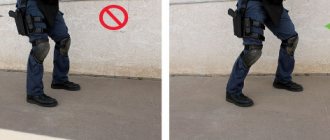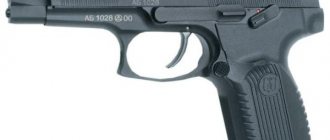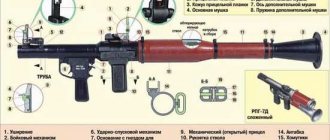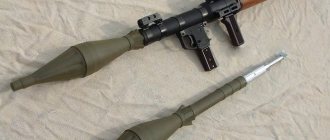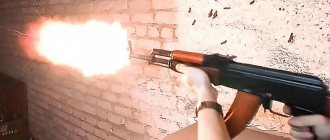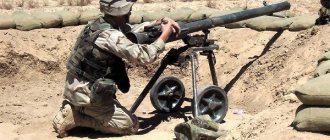Gyrojet. James Bond Rocket Gun
These requirements were met: at a range of 55 m (60 yards), the energy of the rocket exceeded the energy of a bullet fired from a Colt M1911 pistol, and instead of the metallic clang and noise from the explosion of gunpowder, only the hiss of the flying rocket was heard. However, the weapon's disadvantages outweighed its advantages: the pistol was ineffective in close combat, since the missiles needed time to gain speed; due to the lack of stabilizers, the rockets had a high spread; the pistol itself had large dimensions, a small capacity of the integral magazine and low reliability. For this reason, the Gyrojet was not adopted for service, but a number of pistols were purchased by US Army officers and used during the Vietnam War.
Mark 1 Model B Gyrojet in presentation case with medallion. https://americansocietyofarmscollectors.org
James Bond in Ninja with a full set of gyroscopic pistols, carbines and ammunition. https://americansocietyofarmscollectors.org
The low effectiveness in close combat is due to the fact that the missile accelerates outside the guide tube, gaining maximum speed at a considerable distance from the shooter (at the moment of departure from the guide tube, the rocket speed was only about 30 meters per second), which contradicts the principle of using a pistol as a weapon for the latter chance for shooting at minimum distances and is more consistent with existing types of hand-held rocket weapons, that is, grenade launchers.
Sectional Gyrojet showing internal design features. The actual size of the missile is 13 mm or .51 caliber in diameter. https://americansocietyofarmscollectors.org
There were experimental samples of a hand grenade launcher based on this principle; single-shot flare guns were also developed to fire signal flares. This technique (gyrojet flare, A/P25S-5A) was used for quite a long time in the US Air Force to equip downed pilots.
The advantage of such a flare over existing versions of flares (using a pyrotechnic device fired from a variant of a hunting cartridge) is that it is accelerated by the main engine long enough to get out from under the canopy of trees, even if the flare hits branches on the way up and lights up at a decent height above the treetops.
Source/ Source
Found a typo? Select a fragment and press Ctrl+Enter.
Tags: Small arms Gyrojet James Bond pistol rocket pistol
Previous article The mechanism of operation of firearms. Animation
Next article Goodbye Beretta: US Marines will receive a SIG Sauer M18 pistol
Provided by SendPulse
Likes 0
- 0
- 0
- 0
- 0
"Sarafan News"
Getting acquainted with the history of small arms, you can find a lot of interesting and unusual developments that attract increased human attention. One such example is the Gurojet rocket pistol. Created in the early 1960s by designers of the American company MB Associates, the pistol actually fired miniature rockets.
To be completely precise, the development of MB Associates engineers was not a pistol in the literal sense of the word. It was a very unique launcher for launching small solid-propellant rockets or jet bullets, made in the form factor of a standard self-loading pistol. It is known that several rocket pistols could have ended up with the American military in Vietnam. However, they purchased weapons themselves, and the use of an unusual pistol in combat conditions was sporadic. At the same time, the model also did not “take off” in the civilian market, since back in 1968 the federal government banned the use of weapons with a caliber of more than 12 mm in the civilian sector, which, in fact, put an end to the entire development even without taking into account a large number of obvious disadvantages of the Gyrojet rocket pistol.
Gyrojet gun design
The engineers at Mainhardt Biehl Associates turned to the idea of creating an unusual weapon because of the desire to combine in one sample a low noise level when firing and the high efficiency of the ammunition used. With successful development of the project, the weapon would definitely find its niche in the market, ending up in service with fighters of various special units. To achieve their goals, weapon designers Robert Maynard and Arthur Beale decided to turn to non-standard ammunition. The cartridges for the unusual weapons were small-sized rocket shells, which were made of stainless steel. To launch unusual cartridges, the designers created a multi-charge launcher, which outwardly resembled a pistol of impressive size with a striking detail in the form of a perforated barrel. The holes were needed to remove powder gases, but at the same time they created big problems with the use of weapons. The shooter constantly had to ensure that the barrel was not clogged with foreign objects, dirt or sand. The length of the pistol was approximately 300 mm.
The Gurojet launcher itself was made of aluminum, while the lining on the pistol grip was wooden. The improvised pistol received an integral magazine designed for 6 missiles; its location was classic - in the pistol grip. The magazine could only be loaded with individual rocket cartridges and was done through a rear-sliding cover located at the top of the weapon. This created great inconvenience for the shooter, as he could not simply replace the magazine with a new one, which reduced the pistol’s rate of fire. A fixed firing pin was installed in the rear of the launch tube - the barrel, and a trigger was located in front of the magazine.
At the moment when the shooter pressed the trigger, the trigger rotated on its axis up and back, after which it hit the head of a small rocket. Under the influence of the trigger, the miniature rocket moved back, and the primer located in its tail part was pinned onto a fixed, motionless firing pin. After which the powder charge was ignited and the process of accelerating the rocket along the barrel began. While moving, the rocket turned the trigger in the opposite direction, cocking it. At the same time, the shooter could cock the trigger manually; for this he could use a special lever located on the left side of the pistol - the launcher.
Ammunition for rocket pistol
Small rockets (jet bullets) with a pointed tip of 13 mm caliber (13x50 mm cartridge) were used as ammunition for the Gurojet rocket pistol; stainless steel was used for their production. Targets were hit by jet bullets in the same way as conventional pistol bullets due to the influence of kinetic energy. In this case, the burning time of the powder charge in the rocket ammunition was about 0.1 seconds. At the moment of departure from the barrel of the pistol-launcher, the speed of the rocket bullet was only 30 m/s, this is a very low value. The main problem was that the bullet reached its greatest power at a noticeable distance from the pistol, which made it little effective in close combat. This was explained by the design feature - the rocket ammunition accelerated smoothly.
As noted above, at the exit from the barrel the reactive bullet had a speed of only 30 m/s, at a distance of 7 meters the speed increased to 300 m/s (for comparison, the initial speed of the bullet of not the most powerful weapon in the world - the Makarov pistol - is 315 m /With). The bullet reached its maximum speed and kinetic energy at a distance of approximately 20 meters by the time the powder gases were completely burned, then its speed was 380 m/s.
One of the problems with the ammunition was the lack of a tail unit that stabilized the rocket in flight. Although experiments were conducted in this direction, such ammunition for Gurojet was never created. At the same time, the ammunition being tested had very low accuracy, which could hardly be called satisfactory. When firing at distant targets, the significant spread of hits from rocket bullets, which were stabilized in flight only by rotation due to the deflection of part of the powder gases in the radial plane, made the weapon ineffective and inaccurate. According to the manufacturing company, at a distance of 100 meters, the bullet deflection ranged from two to three meters, and in some cases it was even more impressive.
Instead of an afterword
Developed in the 1960s, the unique Gurojet rocket pistol has left its mark on weapons history. During tests carried out at distances of up to 55 meters, the energy of a miniature rocket fired from a pistol was approximately twice the energy of a bullet that the shooter sent to the target from a Colt M1911 pistol (chambered 11.43x23 mm). The weapon met the basic stated requirements - low noise when firing, virtually no recoil, powerful destructive power of ammunition. When firing from a Gurojet rocket pistol, the sound was reduced only to the quiet hiss of a flying rocket. This included ease of operation and repair due to the small number of parts, including moving ones. This is where the positive qualities of the pistol ended.
Actress Karin Dor, one of the "James Bond girls", with a Gurojet rocket pistol
The unusual weapon had a large number of obvious disadvantages that outweighed its advantages. The pistol created by the designers of MB Associates turned out to be ineffective in close combat conditions, since the missiles needed time to gain speed. This practically excluded the use of the Gurojet rocket pistol as a weapon of last chance at minimum firing distances, as pistols are often used in real combat conditions. In addition, the “improvised bullets” had a wide spread due to the lack of stabilizers, and the pistol itself was distinguished by its impressive dimensions. Experts also attributed low reliability and small magazine capacity (only 6 rocket cartridges) to the disadvantages of the unusual weapon. One of the problems was the frequent misfires of new weapons. During testing, approximately one misfire was noted for every 100 shots, which exceeded all permissible values in the weapons industry. It is worth emphasizing here that such misfires were recorded during firing in virtually ideal conditions; during actual combat use of weapons, their number could increase significantly. At an important moment, the weapon could simply fail the shooter, for which in battle people pay with their own lives.
All of the above cooled the interest of gunsmiths in such weapon models for a long time. Until 2020, enthusiastic designers from the American company TAO Fledermaus developed and tested several jet bullets created using 3D printing. The first tests could hardly be called successful, but the designers of TAO Fledermaus have not yet lost interest in the development of such ammunition.
Source: tehnowar.ru
MBA Gyrojet
MBA Gyrojet
Rice. 46. MBA Gyrojet gun
In the early sixties, a small company called MB Associates developed a one-of-a-kind rocket gun known as the Gyrojet. When creating this pistol, its designers, Arthur Beale and Robert Maynard, set themselves the task of creating a low-noise weapon with high efficiency. To achieve this goal, they proposed using miniature rocket shells made of stainless steel and launched from a multi-charge launcher, which looked like a rather bulky pistol with a perforated barrel. The weapon really turned out to be low-noise; when fired, only a loud short hiss was heard, similar to the sound of a flat tire. In addition, at a range of 60 yards (about 50 meters), the energy of a rocket bullet fired from a Gyrojet pistol was almost 2 times higher than the energy of a bullet fired from a Colt M1911A1 pistol at the same range. But that’s where the advantages of Gyrojet ended.
Firstly, due to the use of the rocket principle, the “bullets” gained maximum speed only at a fairly large distance from the barrel, so the Gyrojet was extremely ineffective in close combat.
Secondly, the failure rate was too high (the manufacturer guaranteed 99% reliability, which meant 1 failure per 100 shots).
Thirdly, the accuracy is extremely low - at a range of 100 meters, the manufacturer claimed a hit accuracy of about 2 meters, but in reality the spread of hits at such a range exceeded 3 meters. The missiles were stabilized in flight by spinning them up with powder gases, some of which were diverted into the side nozzles. Experimental rockets stabilized by the tail were also being developed.
All this, combined with the small magazine capacity, large size and low reliability of the entire system, led to the fact that Gyrojet pistols did not gain any noticeable popularity.
Main tactical and technical characteristics:
Features of the kinematic scheme
The Gyrojet launcher (“gun”) was made of aluminum. An integral magazine for 6 missiles was located at the rear of the weapon, in the pistol grip. The magazine was loaded with individual missiles through a sliding cover at the top of the weapon. The fixed firing pin was located at the rear of the launch tube, and there was a trigger in front of the magazine. When you press the trigger, the trigger rotates on its axis up and back and hits the head of the rocket. At the same time, the rocket moved back, and the primer located in its tail part was pinned onto a fixed firing pin. The ignited powder charge began to accelerate the rocket along the “barrel”; while moving forward, the rocket turned the hammer in the opposite direction, thereby cocking it. For manual cocking, there was a special lever on the left side of the weapon.
Description of the pistol-carbine "Tulyak"
Photos of the Tuljak pistol-carbine
The special pistol "Tulyak" 23.3 mm was created on the basis of the OF-93 "Farmer" (a farmer's weapon of the 1993 model) of 12 caliber, which can fire 4-caliber flares, which appeared in 1993 and positioned itself as a cheap and simple weapon for the population, but did not gain popularity and was produced in limited series, as there was no demand. The Farmer gun itself was a 4-gauge rocket launcher with a 12-gauge barrel inserted inside it and screwed into it.
“Tulyak” differs from its brother “Farmer” by its 6-caliber 23.3 mm barrel and the presence of a forend on the barrel. The Tuljak carbine is a simple single-shot pistol, loaded by breaking the barrel. There is a lever on the left side to break the barrel. The handle itself has a safety catch, without squeezing it it is impossible to fire a shot. The butt of the pistol is removable and has pockets for 4 cartridges. According to some reports, “Tulyak” is equipped with an additional 12-gauge barrel, which, like the “Farmer”, is inserted inside a 6-gauge barrel.
The special pistol “Tulyak” can be immediately attributed to several types of weapons: shotguns, pistols, carbines. Shotguns, since they can fire 6-caliber weapon cartridges (23.3 mm), also have a stock. A pistol, since it can shoot without a butt and has a short barrel. Carbines, since it has a rifled barrel, like the special KS-23 carbine and uses the same cartridges (the presence of a rifled barrel has not been confirmed - there is little information).
Since the pistol is in service with the military, we can assume that it has the GRAU index and more detailed characteristics; its low effectiveness is reflected in the lack of information about it. The “Tulyak” pistol can be classified as a “Stone Age” pistol, since it is single-shot, and when performing combat missions it can cost lives. Each shot has to be reloaded, and this is a hassle (you can see this in the bottom view on the example of the “Farmer” gun), and you can’t fire a new shot with the correction. A short barrel for rifle cartridges means poor accuracy, and you have to remove the cartridge case yourself after firing. Shooting like a pistol with 23.3 mm cartridges can result in a dislocated wrist due to recoil. You can say that it is convenient for them to knock out door locks, but this implies an assault on a room where the effect of surprise is needed, and what will happen if the lock does not fly out with the first shot, even if, after successfully breaking the door, you “fly” into the room with an unloaded gun no longer fits into the assault plans. Also, the special pistol does not provide for the installation of tactical flashlights or any sights. And the presence of the multi-shot KS-23 Drozd or the special KS-K-18.5 carbine makes the need for a special Tulyak-23 unlikely. What “Tulyak” is dispersing demonstrators by firing at them with 23-mm tear grenades “Cheryomukha-7”, “Lilac-7” and traumatic cartridges.
Performance characteristics of the special pistol-carbine "Tulyak"
| Number of shots | one |
| Barrel diameter | 6 caliber - 23.3 mm |
| Combat rate of fire | 8-10 rounds per minute |
| Maximum rate of fire | no data |
| Sighting range | varies depending on the types of cartridges |
| Maximum firing range | varies depending on the types of cartridges |
| Initial departure speed | no data |
| Automation | trunk fracture |
| Fire mode | single |
| Weight | 2,2 |
| Dimensions | no data |
Miniature “grenade launcher”: the unenviable fate of the Girojet rocket pistol
There are a great many unique and interesting weapon models that at first seemed promising and then fell into oblivion. Among them is the Girojet rocket pistol. The new product showed great promise, but was created at the wrong time and had several disadvantages that prevented it from becoming widespread.
Gyrojet family
The Gyrojet rocket pistol was released in the first half of the 60s of the last century. It was invented by engineers from MB Associates (USA). The designers dreamed of creating a model that would combine enormous destructive power with relative noiselessness.
In practice, the Girojet fired tiny missiles. Strictly speaking, it was not even a pistol, but a miniature launcher that, when fired, fired jet bullets or solid fuel rockets.
Gyrojet drawing included with the patent
Weapons engineers A. Bill and R. Maynard, when developing an unusual model, realized that other ammunition would be needed. As a result, the designers considered the most suitable rocket projectiles made of stainless steel with a sharp tip of 13 mm caliber (the so-called “rocket bullets”).
Ammunition for the jet family
The unusual appearance of the new item was explained by the presence of a perforated barrel, which attracted the attention of the average person. But such a design was not determined by the aesthetic taste of American gunsmiths, but by necessity: combustion products escaped through the holes. But this structure complicated the use of the pistol: it was necessary to regularly monitor the cleanliness of the holes.
There were other disadvantages that testified against the new product. For example, the Girojet only had an integral magazine capable of holding 6 rounds of ammunition. Thus, it was impossible to quickly replenish ammunition.
Several discovered disadvantages led to the collapse of the project. Widespread production of the rocket pistol was impractical. At present, only isolated cases of the use of this weapon are reliably known, for example, during the Vietnam campaign, but American soldiers themselves bought the model.
The cessation of subsequent developments and the obvious shortcomings of the Girojet led to the fact that since 1968, the US authorities have banned the use of models with a caliber larger than 12 mm by ordinary people. The rocket pistol is finally history.
Subscribe to the Military Observer channel in Yandex.Zen
News Media2
